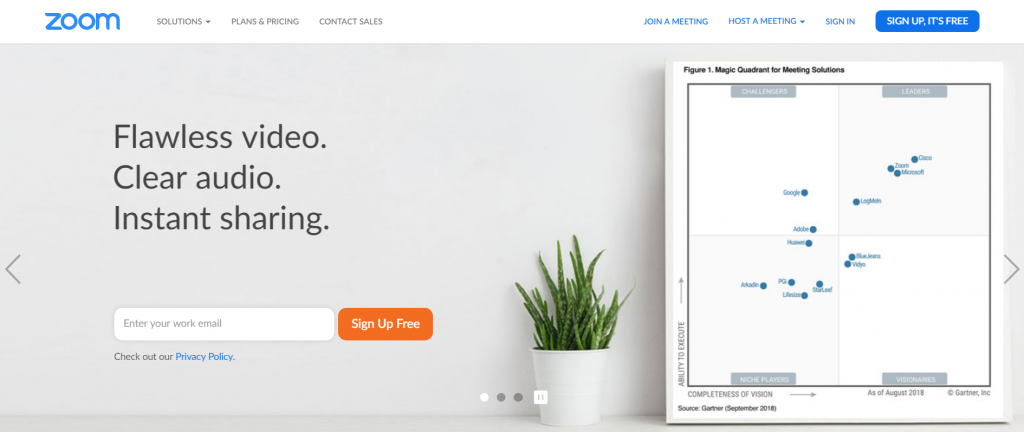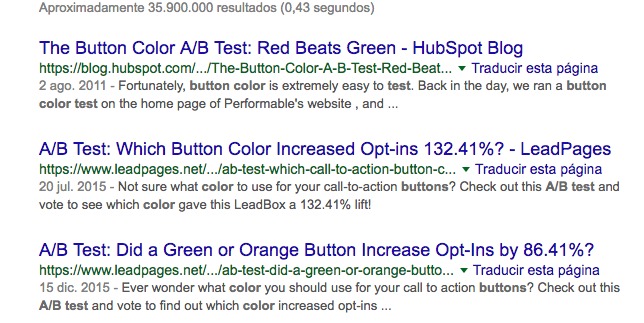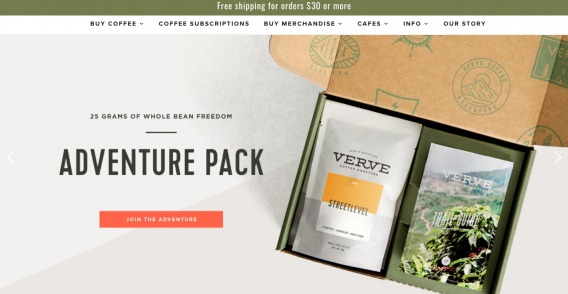The call to action is a core component of marketing, sales, and any persuasion-based effort.
When it comes to calls to action, there’s a lot of theoretical content about how to tweak copy, color, size, and other elements, but, sometimes, it’s easiest to learn through examples.
You can see how theoretical principles play out in the real world, and how they can create effective experiences. Therefore, this post will focus on how to apply theory for calls to action.
A good call to action isn’t the only element you need to succeed online, but a good one will certainly improve your effectiveness. Let’s return quickly to the basics before we dive into any call to action examples.
Table of contents
What is a call to action?
In marketing, a call to action (CTA) is any message designed to prompt an immediate response or encourage an immediate sale. It’s as simple as it sounds: a call for someone to take action.
In the online world, a CTA is a combination of words or phrases that seek to inspire action (usually a button click). In conversion optimization, a typical call to action example would look something like this:
Call to action examples in conversion optimization
A while ago, VWO put out some data that said CTAs were by far the most popular A/B test run on their platform. Some 30% of tests involved a call to action.
This makes sense, especially when you think about how most people learn about conversion rate optimization: through case studies where small CTA tweaks lead to huge lifts.
While a call to action test isn’t always the most impactful area for experimentation, tons of CTAs are so bad that you can pick up some easy wins in this area.
Additionally, no web element lives in isolation. A good CTA draws heavily on the context of the page. When you optimize other elements, your CTA may need tweaking as well.
There are a variety of call to action best practices. I’ll leave the theory, for the most part, to other articles. In this piece, I’ll use examples to guide, instruct, and inspire CTA ideas.
So let’s get to it! Here are 20+ call to action examples.
20 Call to Action Examples (with Reviews and Critiques)
1. Unbounce
After doing tons of button tests, Michael Aagaard realized that two questions can help you write CTA button copy:
- What is my prospect’s motivation for clicking this button?
- What is my prospect going to get when they click this button?
If you can answer those questions concisely and clearly, you’ll have a quality CTA button.

Unbounce’s homepage CTA does that well. “Start My Free Trial” explains exactly what you’re going to get.
2. KlientBoost
It’s tough to shake things up with calls to action. Most offer the same things: “Download Now,” “Get Access,” or “Contact Us.”
KlientBoost does a good job shaking things up, and instead of using something like “Contact Us,” they say “Get My Free Proposal”—seemingly, a more compelling offer. It’s also more specific. You know exactly what the endgame is.
“Contact Us” is vague, but a free proposal is concrete.
3. Usabilla

Not every call to action has to be super clever or witty. In fact, for anybody outside the inbound marketing echo chamber, a CTA saying “Yes! I want to save money and get instant access!” with blinking arrows is annoying.
“Request a Demo” is boring, but if a demo is the desired action, it’s perfectly suitable. Clarity trumps persuasion. Just be consistent. Usabilla does that well, calling for a demo everywhere on their homepage.
4. HotJar

The word “free” is intoxicating for marketers. We sprinkle it everywhere to hype offers, and it usually works wonders. Humans like free stuff.
Therefore, if you have a freemium offer or a free trial, why not emphasize it? One of the biggest hurdles to conversion is uncertainty regarding payment or risk. If you can mitigate that with some soothing copy that assures visitors it “won’t cost you anything,” do it.
5. TaxJar

You don’t have to have the word “free” in the call to action. Sometimes, it’s obvious from the setup or page context. (Pro tip: It’s always about the page context.)
That’s the case with TaxJar, which offers a free trial but uses the more ambiguous “Get started” as the primary CTA. The “free” component is implied—you’re prompted for a username and password (but not credit card information).
6. Bulletproof

Bulletproof has a well-optimized site. The user experience, in my opinion, is excellent. They’re clearly testing things regularly.
The homepage features the prototypical example of an ecommerce call to action: “Shop [product].” It’s not unique or witty, but it moves users immediately toward product browsing.
Along the same lines, we’ve often seen “See Selection” outperform “Shop Now.” Even better, you can personalize your call to action for return visitors or past buyers with a “See What’s New” (as long as you have new things to show):
To complement this, they use a prototypical product page call to action: “Add to Cart.” Most of the time, the conversion optimization best practice is to do what your customer expects. That’s where prototypical design and the science of familiarity come into play.
7. Travel Wisconsin
Travel Wisconsin splits their homepage calls to action two ways: “Our Family Vacation,” and “Trip Ideas for You.” Now, I don’t know their audience well, but I can imagine trip ideas is a more compelling offer, much more in line with the intent of the site visitor.
In any case, the combination of the two CTAs is a bit confusing, and “Our Family Vacation” is completely vague. Everything above the fold is pretty vague, in fact.
Since we initially reviewed their homepage, they’ve updated it to a single (and far clearer) call to action: “Plan your getaway.” If only they hadn’t hidden it by choosing a color that nearly matches the image…

8. CXL

CXL also uses two calls to action, but they serve a specific purpose: to deliver more relevant information to two different sets of buyers.
Once users self-segment, they have the option to see pricing (if they’re ready to buy) or scroll down to learn more:

These things changes, and we’re iterating, so it will be different in the future, but these call to action examples reflect the varying intent of our audience and nature of our offers.
9. BounceX
A CTA doesn’t have to be words in a rectangular box with a contrasting color. A CTA just calls for action. You can get creative with the execution.
BounceX does a great job by making you click play to watch their promo video:
Since initial publication, they’ve ditched the hero video. Maybe it didn’t work. Or maybe they wanted to try something new.
The point stands: Be willing to test something outside the box if it makes sense for your company and audience.
10. Bounce X (Part 2)
BounceX has a treasure trove of behavioral marketing content in their “think tank.”
Each piece of content has a well-designed landing page. Each call to action example could be a case study on how to do things right. The size, color and contrast, affordance—everything about the design is great. In addition, they do copywriting well.
They answer the question, “I want to ____,” and use that as their CTA copy.
11. BounceX (Part 3)
Same story in this example CTA. This call to action is for a webinar, so the copy changes to “Watch it Now,” keeping pace with the context of the offer.
12. Intercom
On their homepage, Intercom maintains consistency with both above-the-fold CTAs. Since they offer a free trial, it’s a simple “Get started” that uses an email opt-in.

13. Zoom
Zoom’s homepage follows a similar structure, with a high-contrast, high-visibility CTA that lets users sign up for free. Note that the use placeholder text to add another call to action: “Enter your work email.”

14. CXL
This is the general call-to-action template we use for our webinars. We’re going for clarity: “Confirm registration.”

15. Tim Ferriss
Tim Ferriss’s call to action is unique both in placement and in offer. His focus is his podcast, so he asks users to “Click to listen.”

16. Paleo Leap
I’m a huge fan of Paleo Leap, but I’m not a big fan of their CTAs. There are dozens of them on the homepage (where does one start?), so it’s difficult to understand the most important desired action.
In addition, the design could use work. The call-to-action examples below are hardly noticeable at a glance. They blend right into the white background.

17. Looker
Looker has two CTAs on their homepage, which goes against CRO “best practices.”

Sure, having only one action per page reduces distraction and makes things clearer for the visitor.
But if you’re selling enterprise software and know you have multiple audiences (in various stages of the customer journey), why not cater to both?
One call to action takes users directly to a form to start a “proof of concept” (i.e. demo). The other brings users to a long-form sales page with plenty of information (about why they should start that demo).
18. Tableau
I’m not a huge fan of Tableau’s call to action. Well, there are actually two above the fold, and the one that pops out is the “The Tableau Platform,” which doesn’t tell you much about what will happen after you click that button.
Is it a trial? A demo? A video? A product page?

The other call to action is eerily similar. “See in Action” could take me to the same content as “The Tableau Platform.” In short, I don’t know which one I should click if I want to learn more about the platform’s features and whether it’s right for me.
If the “See it in action” call to action is vague. Is it a trial, a demo, or just a video? (Spoiler alert: It’s a video.)
19. Verve Coffee
This one is pretty bad.
Starting from the page-context level, the headline and image aren’t super enlightening. I’m not sure what an “adventure pack” is. Then, the call to action is to “Join the Adventure.”
But I’m on a coffee website. I thought I was shopping for coffee. Very confusing. (Thankfully, they’ve since changed it to “Shop now.”)
20. Nomadic Matt
This call to action at the bottom has strong copy: “Send me tips,” which follows the “I Want To ___” formula. It also has an easy and intuitive form and wonderful page context.
The negatives? That call to action is one of three on the page, along with “Search nomadicmatt.com,” which takes up the most prominent real estate and “Shop,” which earns attention due to the high-contrast color.

Before you test your call to action…
This guide is meant to inspire, not to instruct. Every website is contextual, and while I can judge these call-to-action examples against the theory of web design and copywriting, I don’t know how they’re actually performing.
So, here comes the common conversion optimization advice: Test it yourself.
…Or don’t. Maybe it’s not the highest value area for optimization. Maybe you have bigger challenges. Qubit put out an awesome meta-analysis of 6,700+ ecommerce experiments, and they found that CTA tests, on average, don’t move the needle often (and when they do, it’s not by a lot):
Maybe you’ve already tested a ton of CTAs and have a pretty good idea of what works. Call-to-action tests scale well. Once you’ve done enough experimentation, you can usually replicate the winners across similar offers. We use the same CTA across similar landing pages and offers.
If you’re just starting to optimize your website, it may be more beneficial to start with higher impact areas. Use conversion research to discover real problems on your site. Don’t just test calls to action because they’re easy to set up in a visual editor.
Conclusion
The call to action is an important element of website design, conversion optimization, or any form of marketing or persuasion. Invest some time and effort into crafting good CTA copy, making sure the design is right, and designing with the page context in mind.
This post outlined a huge list of call to action examples, probably too many—some good, some bad, some non-existent. You shouldn’t copy any of them outright but rather use them as inspiration to design your own compelling call to action.

















Great read. It’s definitely one of thet first things that comes to mind when testing. A well placed call to action with great content to help the flow of a user is always on my mind.
This trading strategy ebook promotional email campaign has an excellent call to action. Instead of the usual “i want this” or “download now!”. It captured audiences with it’s awesome “GO LONG!” button CTA text.
http://mailchi.mp/1cfa67b346af/use-simple-price-correlation-to-know-stock-prices-before-us-markets-open-47807
I liked it since its relevant to the content of the ebook (Use correlated price movement in international stocks and U.S. ADRs to predict stock prices accurately before markets open.) and it’s audience, which is primarily stock market traders and enthusiasts. Find it here: https://gumroad.com/l/titan0346
This is a really great article, Alex.
One question: you mentioned you’ve seen CTAs like “See Selection” outperform the more generic/familiar CTAs. Did you guys at ConversionXL publish a study on this? I tried searching the site and couldn’t dig anything up.
Thanks for your time :)